

|
|

Yarns and fibers from Apocynum

Apocynum
fiber
Introduction
Indian Hemp (Apocynum cannabinum) or also known
as Dogbane. The common name, Dogbane, refers to the plant's toxic nature, which has been described as "poisonous to dogs." Apocynum means "Away dog!" and cannabinum means "like hemp," in reference to the strong cordage that was made by weaving together the stem's long fibers.
Plant Type: This is a herbaceous plant, it
is a perennial which can reach 1- 4 meters of height. Stems red and branched
emerge from a spreading root.
Leaves: The leaf arrangement is opposite. Each leaf is entire and
spreading or ascending. The lower leaves have stems while the upper leaves may
not.
Flowers: The flowers have 5 Regular Parts and are up to 0.5 cm long. They
are greenish white. Blooms first appear in late spring and continue into late
summer.
Apocynum is a natural herbaceous old root, belonging to peach department, resistance to converse,
drought, to salt and soda, resistance to wind and sand. Apocynum divides into red apocynum and white
apocynum, it's leaf stick and root can be used to drugs. According to "compendium of moeteriu
medica" and "Morterial Medica for Famines" said, apocynum has an effect on stopping palpitation, relieving a
dizziness, reducing phlegm, relieving a cough, strengthening heart and helping passing water. From medical and health care, the
entire body of apocynum is a treasure. It is also an excellent kind of raw material
for the industry.
Properties
Apocynum fiber has a better character than linen or ramie.
It shows a distinct silky shine, the stiffness of flax, the softness of
cotton. It contains cardio tonic glycoside and many kinds of amino-acids
which perform medical care effects which other raw materials of textiles
so not have. Therefore apocynum is called "The king of natures wild fibers".
Textiles made of apocynum not only wear comfortably, but also have health care effect.
Strong, long lasting ropes and fine fishing line could be
made from it and nets from the fiber held up well in water. The American Indians
produced many useful items from the fiber such as pouches and bags, quilts and
clothing. Europeans observed native women making thread from the plant with no
other equipment than their hands and thighs which they used to roll the fibers
into threads. The fibers have been found in archeological sites thousands of
years old.
Interesting properties of
apocynum are:
- Far Infrared Ray
Infrared ray Radiation --> Improving microcirculation.
It was tested that Apocynum Venetum products are natural far infrared radiation materials which can radiate 8-15 micron far infrared light wave, affect
3-5 cm of subcutaneous tissue, and engender biological effects to the body, improve the microcirculation, activate
hislocells, promote metabolism, strengthen immunity. It can also sunder the double or triple key of the disaturable fatty acid in the blood, and form saturation fatty acid, decrease the fat of blood vessels, smooth the blood useful wall, finally decrease disease arising possibilities of cardiovascular and ophthalmology, such as
arteriosclerosis and cataract. Moreover, Japanese medical doctors discovered that 8-15 micron far infrared rate radiation could control the reproduction speed of cancer cells, the pathological changes and development.
- Bacteriostasis
—> Give You A Clean Skin
Apocynum Venetum products can obviously inhibit coli-bacillus, candied albicans, staphylococcus, etc. And it also can prevent chronic dermatitis, bedsores, eczema, etc. After washing 30 tines, the germfree rate is still 10-20 times the rate of ordinary fabric.
Cut an apple in half. One is wrapped with Apocynum Venetum fabric, the other with standard white cotton cloth. Several hours later, the colors, of the two halves are quite different. The one in the standard cotton cloth turns into rotten and gives out peculiar smell, the other only changes a little: obviously, the Apocynum Venetum fiber has the functions of
bacteriostasis and antiseptic, so it can protect human’s health.
- Principle of Pressure Depressing
Apocynum Venetum contains varied medicine compositions such as Flavone
components, Cardinal glycosides, Amino acids, etc. According to the records in Traditional Chinese Medical
Science, the principle lies in that “Inner disease could be cured outside”. The effective medicine composition could pass through the skin pores and
acu-points, play a part in channels, pneuma and blood, inner organs and part focus, part in blood circulation recover the elasticity of the thickened and tough blood vessel wall, thus depressing the blood pressure, promoting the function of organism.
- Warm in winter and cool in summer-the unique property
It was tested and verified that the warm keeping of Apocynum Venetum products is 2 times as much as that of the pure cotton fabric
8°C below. The ventilation is 2.5 times as much as pure cotton fabric
21°C up. The moisture absorption is 5 times as much as pure cotton fabric at the same condition. Wearing Apocynum venetum in scorching summer. There is no sweat smell in 100 hours
| Applications
Uses: Hemp dogbane is known for its use as cordage. Before
cotton was introduced and cultivated, around 700 A.D., leaf and
stem fibers, hair or wool from dogs or wild animals, bird feathers, animal
skins, or human hair were used to create prehistoric cordage. Dogbane fibers
have been found in some archeological sites thousands of years old.
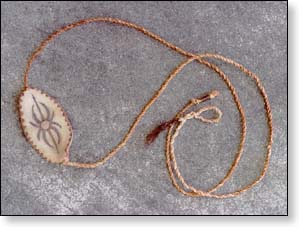 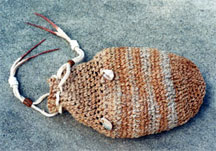
The native people from many nations in many
nations produced various useful
items from the hemp fibers. They made cordage and thread from the plant with no
other equipment than their hands and thighs. Fibers of the dogbane plant were
rolled together to make a functional material stronger than cotton. The twine
was excellent for making fishing lines and nets because it keeps its strength
under water and does not shrink. It was also used in the manufacture of many
other items, including deer and rabbit nets, slings for hunting small game,
nooses for snaring grouse and other game birds, hide stretchers, bowstrings,
moccasins, clothing, straps, woven bedding for baby cradles,
wheels used in a type of dart game, carrying nets, and cat-tail mats.
The stems were harvested late fall, after frosts have caused the sap to drop
into the plant's perennial root base, and the leaves turn to yellow and fall from
the stem. At this stage, the reddish-brown stalk becomes stiff and can easily be
clipped from the root base flush to the ground. Dogbane stalks were also
collected in winter, when the stalks are dry and brittle. Dry stalks are easiest
to work, but if allowed to stand in the field through the winter and into
spring, the fibers weaken. The harvested plants were bundled by the lower ends
for carrying.
The cordage fibers are found in a layer between the thin outer skin and the
woody, hollow center of the stem. Carefully scraping with an obsidian flake,
chert spall, or deer rib removed the outer bark from the fibers. The top
spreading branches were trimmed off and the stems were flattened between the
fingers into four pieces. They were then split open from bottom to top. The
length of brittle, woody core was broken into 2 inch pieces and pulled off the
fibers by hand until all of the 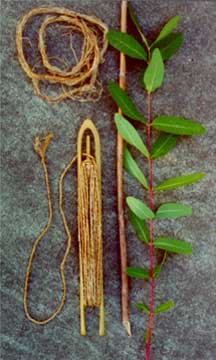 woody
material was removed. Then the process of rubbing and rolling the hemp between
the hands helped clear away any other skin that still clinged to the fibers. Not
everyone scraped the dogbane first. Paiute people and others simply split and
broke the dry stalks without scraping, and removed all the outer bark by
rubbing. Dogbane and other bast fibers can also be soaked (called
"retting") to release the fibers. Retting was used when the bark
adhered more tightly to the fibers. woody
material was removed. Then the process of rubbing and rolling the hemp between
the hands helped clear away any other skin that still clinged to the fibers. Not
everyone scraped the dogbane first. Paiute people and others simply split and
broke the dry stalks without scraping, and removed all the outer bark by
rubbing. Dogbane and other bast fibers can also be soaked (called
"retting") to release the fibers. Retting was used when the bark
adhered more tightly to the fibers.
The dogbane fibers were made into twine by twisting and rolling them with the
hand on the bare thigh. The hands were kept damp to increase the friction. More
stem fibers were joined together by splicing. The short end that needed splicing
was overlapped with the new addition of fibers, then rolled together until they
were intertwined. An average plant yields about 2 1/2 feet of fiber, but one
fourth of this is lost in the splicing process. By splicing the stems together,
a continuous length of twine could be produced. A strong rope could be made by
plying several lengths of twine together. A good Indian hemp rope is said to
have the equivalent strength of a modern hemp rope with a breaking point of
several hundred pounds. The twine would keep for many years if stored in a dry
place.
In todays textiles apocynum fibers are
mostly mixed with long staple cotton fibers. End uses are
decoration fabric, bed covers, curtaining etc.
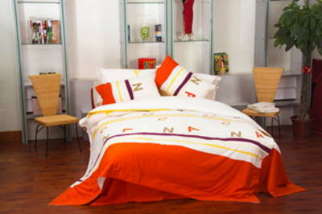
|
Number:1223
|
Component:15%
Apocynum Venetum 85%Cotton
|
|
Description:
Infrared
ray Radiation; Bacteriostasis; Warm in winter and cool
in summer. SPECIFICATION
(seven-piece) Quilt Cover 230cm X 200cm; Sheet 240cm X
220cm
|
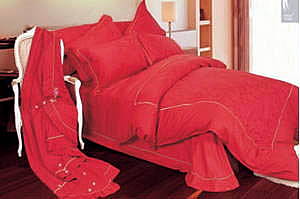
|
Number:1208
|
Component:15%
Apocynum Venetum 85%Cotton
|
|
Description:
Infrared
ray Radiation; Bacteriostasis; Warm in winter and cool
in summer. SPECIFICATION A: Quilt Cover 240cm X 220cm;
Sheet 260cm X 240cm; Pillowcase 75cm X
50cm.SPECIFICATION B: Quilt 230cm X 203cm; Sheet
260cm X 240cm; Pillowcase 75cm X 50cm
|
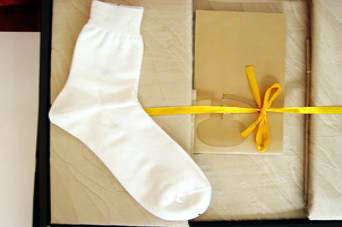
|
Number:YT05
|
component:
apocynum
and
cotton
|
|
Description:
Deodorize,
distribute the sweat, bacteriostatic
Component: 25% apocynum, 45% cotton, 25%
polyamide, 5% rubber
|
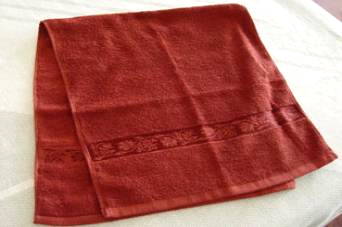
|
Number:YT08
|
component:16% Apocynum Venetum, 84%Cotton
|
|
Standard:33cm
X 76cm
|
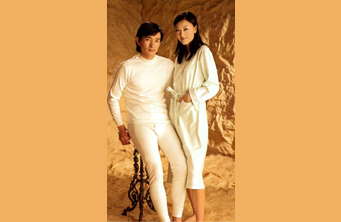
|
Number:YT03
|
component:25%
Apocynum, 75%Cotton
|
|
| Grades
|
There are the following main product yarn qualities made from apocynum:
- Apocynum 30%/combed long-staple cotton 70%,
siro-spun yarn 16s-40s
- Apocynum 30%/combed long-staple cotton 70%,
ring-spun yarn 16s-80s
- Apocynum 25%/combed long-staple cotton 75%,
siro-spun yarn 16s-40s
- Apocynum 25%/combed long-staple
cotton 75%,
ring spun yarn 16s-80s
- Apocynum 15%/combed long-staple cotton 85%,
siro-spun yarn 16s-40s
- Apocynum 15%/combed long-staple cotton 85%,
ring spun yarn 16s-80s
- Apocynum/combed long staple cotton
O.E. yarn 6s-16s
- Apocynum/Tencel/ long staple cotton
siro-spun yarn 16s-40s
- Apocynum/Tencel/ long staple cotton
ring spun yarn 16s-80s
- Apocynum/ small denier viscose
siro-spun yarn 16s-40s
- Apocynum/colored cotton /Tencel
siro-spun yarn 16s-40s
|
| Processability
Apocynum fibers need to be
cottonized for spinning on ring spinning or OE equipment.
This process is the crucial point to ensure a perfect
running in the spinning workshop |
| Background
information
Medical Uses: The dried and powered root used by Native Americans as a snuff to cause sneezing and thus relieve a head cold. Like Spreading Dogbane (A. Androsamifolium) the plant taken internally could produced anything from a mild diuretic and laxative effect to a purgative effect with profuse sweating depending on the dose and the potency of the plant. Even so some tribes used it as a tonic. The Chickasaw and Choctaw reportedly used to treat syphilis by chewing the fresh root and swallowing the juice. It contains cymarin and apocannoside, glycosides that have shown anti-tumor activity. Warning: Poisonous, possibly deadly, in sufficient doses!
|
| Our
supplier partner
|
|
|



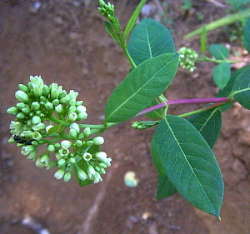


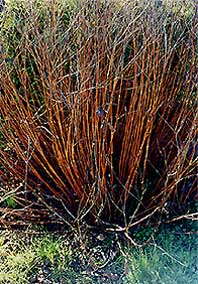
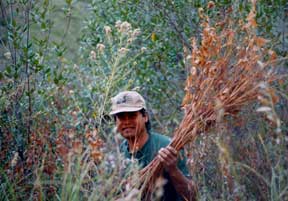
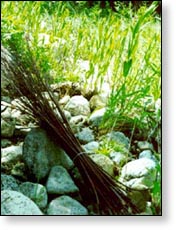
 woody
material was removed. Then the process of rubbing and rolling the hemp between
the hands helped clear away any other skin that still clinged to the fibers. Not
everyone scraped the dogbane first. Paiute people and others simply split and
broke the dry stalks without scraping, and removed all the outer bark by
rubbing. Dogbane and other bast fibers can also be soaked (called
"retting") to release the fibers. Retting was used when the bark
adhered more tightly to the fibers.
woody
material was removed. Then the process of rubbing and rolling the hemp between
the hands helped clear away any other skin that still clinged to the fibers. Not
everyone scraped the dogbane first. Paiute people and others simply split and
broke the dry stalks without scraping, and removed all the outer bark by
rubbing. Dogbane and other bast fibers can also be soaked (called
"retting") to release the fibers. Retting was used when the bark
adhered more tightly to the fibers.



